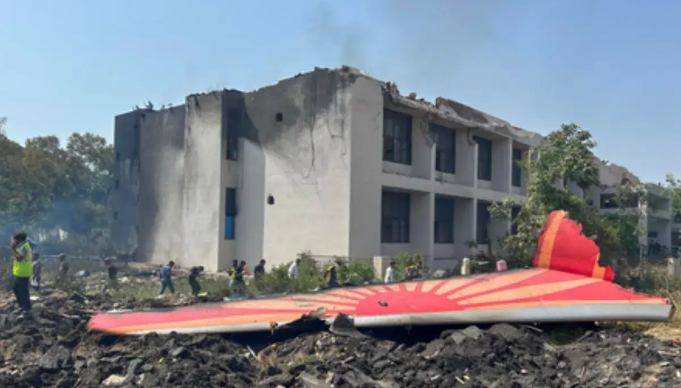
Ahmedabad, India : 13th June 2025
In a tragic and shocking incident, an Air India Boeing 787-8 Dreamliner crashed shortly after take-off from Ahmedabad airport, killing 241 people onboard. Only one person, a British national of Indian origin, miraculously survived what is now being called one of the worst air crashes in Indian aviation history.
Black Box Found on Doctors’ Hostel Roof
A major breakthrough in the investigation came when the black box of the crashed aircraft was found. This device, officially known as the Digital Flight Data Recorder (DFDR), was located on the roof of a doctors’ hostel, which the aircraft crashed into. The black box will be a key piece of evidence in finding out what caused this devastating accident.
Although it’s called a “black box,” the device is actually bright orange so that it can be easily seen in the wreckage or underwater. The DFDR records crucial flight information such as airspeed, altitude, engine performance, and cockpit audio, including communication between the pilots and air traffic control. It is built to survive extreme heat, water damage, and severe impact, ensuring the valuable data inside remains protected.
The search and recovery operation was led by the Aircraft Accident Investigation Bureau (AAIB) and supported by over 40 personnel from the Gujarat government.
Vital Role of the Black Box
Experts believe that the black box holds the answers to what went wrong during the flight. The device is made of highly durable materials like steel and titanium and consists of two main parts – the DFDR, which records the flight’s technical parameters, and the Cockpit Voice Recorder (CVR), which stores audio from the cockpit. This includes pilot conversations, warning signals, and any communication with the air traffic control tower. This vital information will now be sent for analysis, which could take days or even weeks.
What Happened During the Flight
The doomed flight was traveling from Ahmedabad to London, with a total of 242 people onboard, including the crew. A CCTV camera from the Ahmedabad airport recorded the aircraft as it took off. In the beginning, everything appeared normal. The plane gained speed on the runway and took off as expected. But within seconds, the aircraft failed to climb as high as it should have. It seemed to fly at a level height for a few seconds before losing altitude rapidly.
Moments later, the aircraft crashed into the doctors’ hostel of a nearby medical college. The visuals from the CCTV clearly showed that the flight was in trouble. By the time emergency services could respond, it was already too late.
Investigation Underway
Following the crash, Tata Sons Chairman N Chandrashekhar confirmed that investigation teams from India, the United States, and the United Kingdom had reached the crash site within 24 hours. He said, “Trained investigators will help us understand why this routine flight turned into a disaster.” The collaboration between international agencies will be crucial in determining whether the crash was caused by technical failure, pilot error, or other unknown factors.
Details About the Aircraft
The aircraft involved in the crash was a Boeing 787-8 Dreamliner, which was 12 years old. It was part of Air India’s international fleet and had recently cleared all necessary safety inspections. The Dreamliner is known for its modern design, fuel efficiency, and high reliability. This makes the accident even more shocking, as the plane model is considered one of the safest in the world.
Lone Survivor to Be Questioned
The only surviving passenger is currently receiving treatment in a hospital. Authorities say the individual is in stable condition and may be able to speak to investigators soon. If they are able to remember the events that occurred inside the plane before the crash, it could provide critical insights into what went wrong.
Eyewitness Accounts of the Crash
People living near the crash site and students at the medical college shared terrifying stories. A student who was in the hostel said, “We heard a huge explosion and ran outside. The building was shaking. When we looked up, we saw fire and smoke in the sky. It was horrifying.” Local residents and first responders were among the first to reach the scene, but sadly, the destruction was too severe for any rescue.
Safety Concerns and Grounded Aircraft
The tragic crash has raised serious concerns about aviation safety in India. The Directorate General of Civil Aviation (DGCA) has already announced that it is grounding all other Dreamliners in Air India’s fleet for thorough inspection. Experts say this is a necessary precaution to prevent any further incidents until the full cause is determined.
Worldwide Reaction
The crash has drawn attention from across the globe. Leaders from India, the UK, and the US have sent their condolences to the families of the victims. The Prime Minister of India, the UK Prime Minister, and senior officials from the US State Department expressed deep sorrow and support.
Aircraft manufacturer Boeing also issued a statement saying it is in touch with Air India and the investigating authorities, and will provide full cooperation. The company said, “We are deeply saddened by this loss and are here to assist in every way possible.”
Now that the black box has been found, it will be sent to laboratories for data analysis. Investigators will work around the clock to extract and interpret the flight data. Based on the findings, the government may announce changes in aviation safety rules, pilot training, and aircraft maintenance policies.
The DGCA, in collaboration with international aviation agencies, is expected to conduct a full safety audit of Air India’s operations. This includes checking aircraft health records, staff training procedures, and emergency response systems.
The crash of the Air India Dreamliner in Ahmedabad is a dark moment in Indian aviation history. It has left hundreds of families grieving and a nation in shock. With the black box now recovered, there is hope that investigators will uncover the truth behind this terrible disaster.
While nothing can replace the lives lost, the information from the black box could help prevent similar tragedies in the future. As the world watches and waits for answers, one thing is clear — the aviation industry must come together to ensure passenger safety remains the highest priority.































